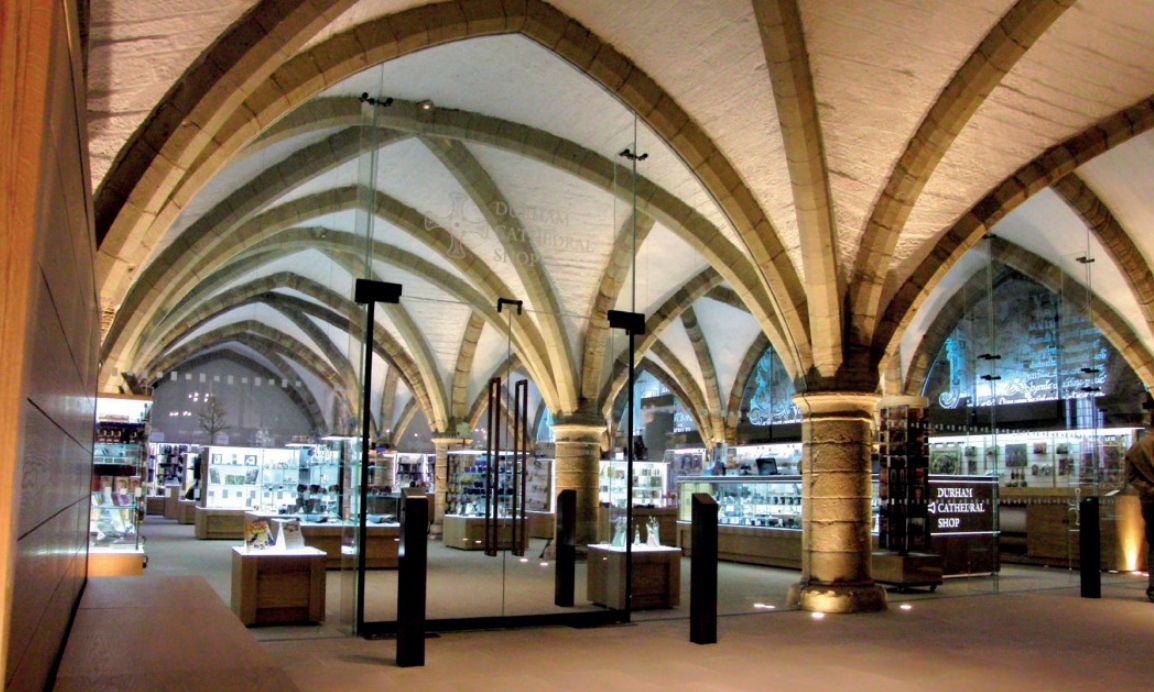Durham Cathedral's Open Treasure project
The Open Treasure project has widened public access to the hidden architectural spaces and collections of Durham Cathedral by making creative use of the claustral buildings.

|
| Durham Cathedral’s hidden treasures included architectural spaces and artefacts from its collections. |
Durham Cathedral, the most significant and complete Romanesque cathedral in Europe, retaining a near-complete and intact range of Benedictine claustral buildings. The cathedral houses the largest in-situ collection of medieval manuscripts and early printed books of any English cathedral.
Chris Cotton, cathedral architect and partner to Purcell’s York Studio, led his team in the delivery of an extensive programme of works known as Open Treasure. These works were agreed following research to understand the complexity of the project, and to define the brief and priorities. The process included extensive expert research, coupled with programmes of consultation and public engagement.
The dean and chapter’s ambition was to widen public access to the cathedral’s hidden treasures, including architectural spaces as well as pieces from the collection. This became a Heritage Lottery Fund project, with other funding streams supporting the project. It included a scaled Lego model of the cathedral.
The project’s biggest challenges lay in four spaces which surround the cloisters: the Refectory Library; the Collections Gallery; the Monks’ Dormitory; and the Great Kitchen. Despite their outstanding value, they were mostly inaccessible and required urgent repairs. The project elements which were intended to form new exhibition and library facilities also had to deliver new environmental controls, set in the context of a historic building constructed from porous materials and with extremely limited plant space.
Among other specialist and consultants, Tobit Curteis, David Odgers and TGA Consulting Engineers were appointed to work with Purcell to undertake the analysis of the existing condition, while creating sensitive and suitable solutions to manage environmental conditions. Due to the different uses proposed, each space needed its own bespoke approach, including its building services.
The quinquennial inspection and report published in 2013 indicated the requirement for urgent repair works and set out what management was to be expected. Once the brief had been agreed and the team appointed, the process began undertaking detailed trials, including sampling and materials analysis. This was in conjunction with an extended period of environmental monitoring by Tobit Curteis as specialist in environmental monitoring. TGA Consulting Engineers undertook detailed surveys of the existing engineering services to establish how best to approach the proposals while minimising the risk of loss of services and damage to the historic fabric.
Although known as a tourist attraction, the cathedral sits at the heart of the religious community, so any interventions had to be mindful of the site’s intended purpose. The events and services had to be minimally impacted throughout the project. An assessment was carried out of how building defects, historic and modern materials, water and moisture, heating regimes, and environment were combining to hasten the decay and failure of historic material. The four key spaces all had different defects, but they had the opportunity to become part of the visitor and user experience, allowing collections of which some were to be shown for the first time.
The Refectory Library contains the cathedral’s collection of rare early printed books, housed in the former medieval refectory, which was refitted in the early 18th century. This had become unstable. The environmental conditions, including humidity, temperature and ultra-violet light, had to be stabilised. These interventions have ensured the protection of the valuable books and manuscripts to be read in the adjacent space, a new Reading Room.
The Collections Gallery, where some of the most sensitive artefacts are displayed, now has a close control air-conditioning system. The new systems had to be carefully segregated from the historic building fabric. The conservation team specified passive display cases, incorporating silica gel in mesh bags, to work in conjunction with the environmental controls to achieve target conditions.
The gallery showcases precious artefacts in a state-of-the-art gallery, renovated with exceptionally high levels of environmental control and security. From the Collections Gallery a new stair and lift and opened passageway leads to the Great Kitchen Exhibition space. This required complex archaeology and dismantling of low-significance fabric, giving access to all for all the spaces for the first time.
The Monks’ Dormitory, one of England’s most significant medieval halls, dating back to the 14th century, is the country’s last intact dormitory. The historic room, boasting a long oak-beamed roof and large open spaces, presented itself perfectly to become the exhibition space displaying the cathedral’s collection, a narrative interactive exhibit and objects such as Anglo-Saxon stones.
A new lift was sensitively designed and installed. New services included heating and lighting systems. The heating system is controlled on conservation heating principles, with low temperature hot water supplied to perimeter radiators and finned heating tubes. These are supplemented by locally controlled heating at library desks and staff positions, as it is sometimes necessary to reduce the general heating of the room to maintain environmental conditions.
The Great Kitchen, also built in the 14th century, is a rare example of a medieval English monastic kitchen. The distinctive octagonal ceiling with rib vaults has become the home of the Anglo-Saxon Treasures of St Cuthbert display. The conservation project consisted of significant restoration of the decaying stone of the roof vault and walls, and innovative solutions tackling key defects to the space.
Tests had revealed that the space had a relative humidity of between 60 and 85 per cent, caused by moisture ingress through the fabric. This, and frequent changing air temperatures between 9 and 18 degrees, meant that magnesium sulphate salts, inherent in historic lime mortars, were being activated. This led to the crypto-florescent cycle occurring regularly between crystal and liquid states of the magnesium sulphate salts. This was causing damage to the UK’s only remaining stone-vaulted kitchen.
To control relative humidity and combat the decay, the Great Kitchen’s concrete slab floor was removed and replaced with a limecrete breathable one which incorporates a floor duct. The installation of a new conservation-focused heating system then enabled air to be ducted through the floor at low pressure over finned heating pipes.
The new environmental control system is a hybrid solution which includes close control air conditioning with plant located in confined spaces concealed in wall structures. The air conditioning has been set up so as to be able to dehumidify, if other means fail to adequately control the environment, but it cannot actively introduce moisture.
Electrical services were routed under the floor, but sensitively located above archeologically sensitive layers. The room is protected by a carefully concealed aspirating smoke detection system.
By improving and managing these conditions using traditional, conservation repairs, the new mechanical engineering systems have delivered stable and safe conditions for the fragile Anglo- Saxon silks, manuscripts and artefacts. The interior was also relit to display the architectural and archaeological qualities of the room.
The environment in each of the spaces is now stable and within target ranges enabling the rooms and their contents to be enjoyed by thousands of visitors. The relative humidity of the kitchen, for example, is now averaging 49 per cent, with temperatures that gradually change through the seasons to maintain this level. The oscillation of magnesium sulphates has been stabilised. As a result the cathedral is now able to display in passive cases the Anglo-Saxon-period silks, early medieval manuscripts, and the Anglo-Saxon coffin associated with the shrine of St Cuthbert.

|
| Installing air-conditioning in the Collections Gallery enabled the display cabinets to rely on passive environmental controls alone. |
This article originally appeared as ‘Servicing Durham Cathedral’s Open Treasure project’ in IHBC's Context 159 (Page 28), published in May 2019. It was written by Louise Priestman, a conservation accredited architect who works for Purcell Architects.
--Institute of Historic Building Conservation
Related articles on Designing Buildings
- Building a Crossing Tower: a design for Rouen Cathedral of 1516.
- Building services.
- Cathedral.
- Cathedral of Brasilia.
- Cologne Cathedral.
- Conservation.
- Dunelm House, Durham.
- Florence Cathedral.
- IHBC articles.
- Medieval architecture.
- Sourcing stone to repair Exeter Cathedral.
- St Pauls Cathedral.
- St. Basil's Cathedral.
- The Institute of Historic Building Conservation.
IHBC NewsBlog
IHBC Membership Journal Context - Latest Issue on 'Hadrian's Wall' Published
The issue includes takes on the wall 'end-to-end' including 'the man who saved it'.
Heritage Building Retrofit Toolkit developed by City of London and Purcell
The toolkit is designed to provide clear and actionable guidance for owners, occupiers and caretakers of historic and listed buildings.
70 countries sign Declaration de Chaillot at Buildings & Climate Global Forum
The declaration is a foundational document enabling progress towards a ‘rapid, fair, and effective transition of the buildings sector’
Bookings open for IHBC Annual School 12-15 June 2024
Theme: Place and Building Care - Finance, Policy and People in Conservation Practice
Rare Sliding Canal Bridge in the UK gets a Major Update
A moveable rail bridge over the Stainforth and Keadby Canal in the Midlands in England has been completely overhauled.
'Restoration and Renewal: Developing the strategic case' Published
The House of Commons Library has published the research briefing, outlining the different options for the Palace of Westminster.
Brum’s Broad Street skyscraper plans approved with unusual rule for residents
A report by a council officer says that the development would provide for a mix of accommodation in a ‘high quality, secure environment...
English Housing Survey 2022 to 2023
Initial findings from the English Housing Survey 2022 to 2023 have been published.
Audit Wales research report: Sustainable development?
A new report from Audit Wales examines how Welsh Councils are supporting repurposing and regeneration of vacant properties and brownfield sites.
New Guidance Launched on ‘Understanding Special Historic Interest in Listing’
Historic England (HE) has published this guidance to help people better understand special historic interest, one of the two main criteria used to decide whether a building can be listed or not.

















